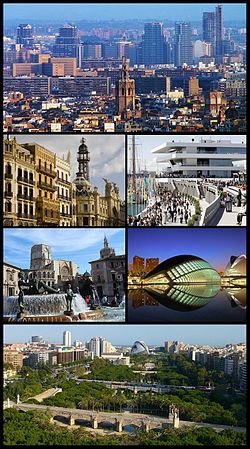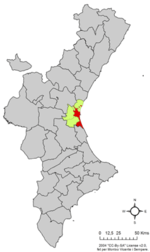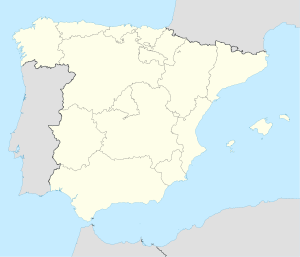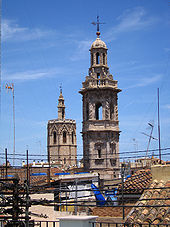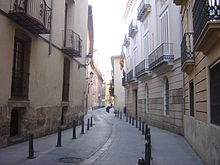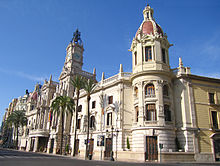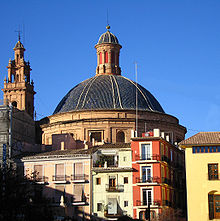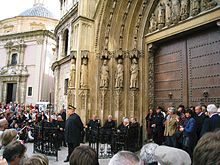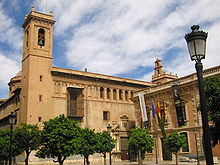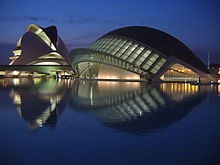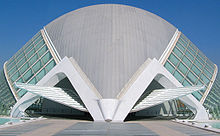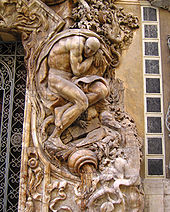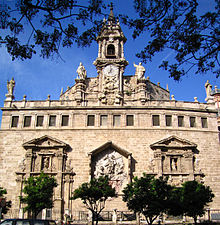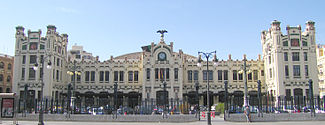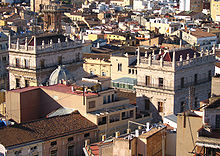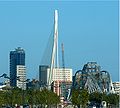- Valencia, Spain
-
This article is about the city in Spain. For other uses, see Valencia (disambiguation).
Valencia
València/ValenciaClockwise from top, Valencia skyline, Veles e Vents building, City of Arts and Science, Turia Riverbed Gardens, Virgin Square (Turia Fountain and Cathedral), modernist buildings in Tow Hall Square. 
Flag
Coat of armsLocation of Valencia in the Valencian Community Location of Valencia in Spain Coordinates: 39°28′13″N 0°22′36″W / 39.470239°N 0.376805°WCoordinates: 39°28′13″N 0°22′36″W / 39.470239°N 0.376805°W Country  Spain
SpainAutonomous Community  Valencian Community
Valencian CommunityProvince Valencia Comarca Valencia Founded 137 BC Districts Ciutat Vella, Eixample, Extramurs, Campanar, Saïdia, Pla del Real, Olivereta, Patraix, Jesús, Quatre Carreres, Poblados Marítimos, Caminos al Grao, Algirós, Benimaclet, Poblados del Norte, Poblados del Oeste, Poblados del Sur Government – Type Mayor-council government – Body Ajuntament de València – Mayor Rita Barberá (PP) Area – City 134.65 km2 (52 sq mi) Elevation 15 m (49 ft) Population (2010)INE – City 809,267 – Density 6,010.2/km2 (15,566.2/sq mi) – Urban 1,175,000 to 1,564,145 – Metro 1,705,742 to 2,300,000 Demonym valencià (m), valenciana (f)
valenciano (m), valenciana (f)Time zone CET (GMT +1) – Summer (DST) CEST (GMT +2) (UTC) Postcode 46000-46080 ISO 3166-2 ES-V Website http://www.valencia.es Valencia (Spanish: [baˈlenθja]) or València (Valencian: [vaˈlensia]) is the capital and most populous city of the autonomous community of Valencia and the third largest city in Spain, with a population of 809,267 in 2010.[1] It is the 15th-most populous municipality in the European Union. About 1,175,000[2] or 1,564,145[3] people live in the Valencia urban area and 1,705,742[4][5][6] or 2,300,000[7] in the Valencia metropolitan area.
It is integrated into an industrial area on the Costa del Azahar. Its main festival, the Falles, is known worldwide, while the traditional dish, paella, originated in the Valencian Community.
The city contains a dense monumental heritage, including the Llotja de la Seda (World Heritage Site since 1996), but its landmark is undoubtedly the City of Arts and Sciences, an avant-garde and futuristic museum complex.
Contents
Name
The original Latin name of the city was Valentia (Latin pronunciation: [waˈlentia]), meaning "strength", "valour", the city being named for the Roman practice of recognizing the valour of former Roman soldiers after a war. The Roman historian Titus Livius (Livy) explains that the founding of Valentia in the 2nd century BC was due to the settling of the Roman soldiers who fought against Iberian local rebel, Viriatus.
During the rule of the Muslim Empires in Spain, it was known as بلنسية (Balansiyya) in Arabic.
By regular sound changes, this has become Valencia [baˈlenθja] in Castilian and València [vaˈlensia] in Valencian (in Valencian the grave accent <è> /ɛ/ contrasts with the acute accent <é> /e/, nevertheless the word València is an exception to this rule which is spelled according to Catalan etymology, though it uses a pronunciation closer to Vulgar Latin).
History
During the Roman period Valencia formed part of the then province of Edetania. The Roman historian Florus says that in 140 BC Junius Brutus transferred the soldiers who had fought under him to that province: the Roman city, known as Valentia Edetanorum, was founded in 137 BC on the site of a former Iberian town, by the river Turia.
Later it was a Roman military colony. In punishment for its adherence to Sertorius it was destroyed by Pompey, but was later rebuilt, and Pomponius Mela says that it was one of the principal cities of Tarraconensis province.
The city has been occupied by the Visigoths, the Moors and the Catalan and Aragonese.
The city surrendered without a fight to the invading Moors (Berbers and Arabs) in 714 AD, and the cathedral of saint Vincent was turned into a mosque. When Islamic culture settled in, Valencia – then Balansiya – prospered from the 10th century, thanks to a booming trade in paper, silk, leather, ceramics, glass and silver-work. The architectural legacy from this period is abundant in Valencia and can still be appreciated today in the remains of the old walls, the Baños del Almirante bath house, Portal de Valldigna street and even the Cathedral and the tower, El Micalet, which was the minaret of the old mosque.
After the death of Almanzor and the unrest that followed, Muslim Al-Andalus broke up into numerous small states known as taifas, one of which was the Taifa of Valencia which would exist for four distinct periods - 1010 to 1065, 1075 to 1099, 1145 to 1147 and last from 1229 to 1238.
'the Cid' conquered Valencia for the short period from 15 June 1094 – July 1099. He turned nine mosques into churches and installed the French monk Jérôme as bishop (this victory was immortalised in the Lay of the Cid). On the death of the Cid (July 1099), his wife, Ximena, retained power for two years, after which Valencia was besieged by the Almoravids.
The city was returned to the Almoravids in 1102. Although the 'Emperor of Spain' Alfonso drove them from the city, he was not strong enough to hold it. The Christians set fire to it, abandoned it, and the Almoravid Masdali took possession of it on 5 May 1109. The event was commemorated in a poem by Ibn Khafaja in which he thanked Yusuf ibn Tashfin for the liberation of the city. The Almoravid and the Almohad dynasty would rule Valencia for more than a century.
In 1238, King James I of Aragon the Conqueror, with an army composed of Aragonese, Catalans, Navarrese and some French, English, German and Italian crusaders, laid siege to Valencia and on 28 September in that year forced a surrender. 50,000 Moors were forced to leave. Poets like Ibn al-Abbar and Ibn Amira mourned their exile from their beloved Valencia.
On 9 October, King James, followed by his retinue and army, took possession. The principal mosque was turned into a Church where Mass was celebrated and the "Te Deum" sung. James incorporated city and territory into the newly formed Kingdom of Valencia, one of the kingdoms forming the Crown of Aragon, and permitted all people that lived in the city (Muslims and Christians) to stay there and live as citizens of the kingdom.
Catholic sources state that Saint Vincent Ferrer preached so successfully (sometime between 1390 and 1411), converting thousands of Jews, that he was permitted to employ the synagogue for his newly-founded hospital of San Salvador.
In the 15th and 16th centuries, Valencia was one of the major cities in the Mediterranean. The writer Joanot Martorell, author of Tirant lo Blanch, and the poet Ausiàs March are famous Valencians of that era.
The first printing press in the Iberian Peninsula was located in Valencia. The first printed Bible in a Romance language, Valencian Bible, was printed in Valencia circa 1478, attributed to Bonifaci Ferrer.
Valencian bankers lent funds to Queen Isabella I of Castile for Columbus' trip in 1492.
In 1519–1522 the Guilds revolts took place. In 1609, the Moriscos were expelled from the city.
During the War of the Spanish Succession, Valencia sided with Charles of Austria. On 24 January 1706, Charles Mordaunt, 3rd Earl of Peterborough, 1st Earl of Monmouth, led a handful of English cavalrymen into the city after riding south from Barcelona, capturing the nearby fortress at Sagunt, and bluffing the Spanish Bourbon army into withdrawal.
The English held the city for 16 months and defeated several attempts to expel them. English soldiers advanced as far as Requena on the road to Madrid. After the victory of the Bourbons at the Battle of Almansa (25 April 1707), the English army evacuated Valencia and the city subsequently lost its privileges, including important civil rights called furs by the way the Bourbons decided to burn important cities like Xativa, where actually is still the picture of the Spanish Bourbon turned back as protest.
During the Peninsular War Valencia was besieged by the French under Marshal Suchet from Christmas Day 1811, until it fell on 8 January the next year.
The last victim of the Spanish Inquisition, a local schoolteacher called Cayetano Ripoll, was executed in Valencia in July 1826 accused of being a deist and freemason.
During the Spanish Civil War, the capital of the Republic was moved to Valencia. The city suffered from the blockade and siege by Franco's forces. The postwar period was hard for Valencians. During the Franco years, speaking or teaching Valencian was prohibited; in a significant reversal it is now compulsory for every child studying in Valencia.
Modern history
In 1957 the city suffered a severe flood by the Turia River, with 5 metres (16 ft) of water in some streets. One consequence of this was that a decision was made to drain and reroute the river and it now passes around the Western and southern suburbs of the city. A plan to turn the drained area into a motorway was dropped in favour of a picturesque 7 km (4 mi) park which bisects the city.
Valencia was granted Autonomous Statutes in 1982.
On 9 July 2006, during Mass at Valencia's Cathedral, Our Lady of the Forsaken Basilica, Pope Benedict XVI used, at the World Day of Families, the Santo Caliz, a 1st-century Middle-Eastern artifact believed by many to be the Holy Grail. It was supposedly brought to that church by Emperor Valerian in the 3rd century, after having been brought by St. Peter to Rome from Jerusalem. The Santo Caliz ("Holy Chalice") is a simple, small stone cup. Its base was added in medieval times and consists of fine gold, alabaster and gem stones.[8]
Valencia was selected in 2003 to host the historic America's Cup yacht race, the first European city ever to do so. The America's Cup matches took place in summer 2007. On 3 July 2007, Alinghi defeated Team New Zealand and successfully defended the America's Cup. 22 days later, on 25 July 2007, the leaders of the Alinghi syndicate, holder of the America's Cup, officially announced that Valencia would be the host city for the 33rd America's Cup, held in June 2009.[9]
Main sights
Architecture
The ancient winding streets of the Barrio del Carmen contain buildings dating to Roman and Arabic times. The Cathedral, built between the 13th and 15th century, is primarily of Gothic style but contains elements of Baroque and Romanesque architecture. Beside the Cathedral is the Gothic Basilica of the Virgin (Basílica De La Virgen De Los Desamparados). The 15th century Serrano and Quart towers are part of what was once the wall surrounding the city.
UNESCO has recognised the silk exchange market (La Lonja de la Seda), erected in early Valencian gothic style, as a World Heritage Site.[10] The modernist Central Market (Mercado Central) is one of the largest in Europe. The main railway station Estación Del Norte is built in modernisme (the Spanish version of Art Nouveau) style.
World-renowned (and city-born) architect Santiago Calatrava produced the futuristic City of Arts and Sciences (Ciutat de les Arts i les Ciències), which contains an opera house/performing arts centre, a science museum, an IMAX cinema/planetarium, an oceanographic park and other structures such as a long covered walkway and restaurants. Calatrava is also responsible for the bridge named after him in the center of the city. The Music Palace (Palau De La Música) is another good example of modern architecture in Valencia.
The cathedral
The cathedral was called Iglesia Mayor in the early days of the Reconquista, then Seo (from Latin sedes, i.e. (archiepiscopal) see), and in virtue of the papal concession of 16 October 1866, it was called the Basilica metropolitana. It is situated in the centre of the ancient Roman city where some believe the temple of Diana stood. In Gothic times, it seems to have been dedicated to the most Holy Saviour; the Cid dedicated it to the Blessed Virgin; King James I of Aragon did likewise, leaving in the main chapel the image of the Blessed Virgin which he carried with him and which is believed to be the one which is now preserved in the sacristy. The Moorish mosque, which had been converted into a Christian church by the conqueror, appeared unworthy of the title of the cathedral of Valencia, and in 1262 Bishop Andrés de Albalat laid the cornerstone of the new Gothic building, with three naves; these reach only to the choir of the present building. Bishop Vidal de Blanes built the chapter hall, and James I of Aragon added the tower, called "Miguelete" because it was blessed on St. Michael's day in 1418, which is about 58 m high and finished at the top with a belfry.
In the 15th century the dome was added and the naves extended back of the choir, uniting the building to the tower and forming a main entrance. Archbishop Luis Alfonso de los Cameros began the building of the main chapel in 1674; the walls were decorated with marbles and bronzes in the over-ornate style of that decadent period. At the beginning of the 18th century the German Conrad Rudolphus built the façade of the main entrance. The other two doors lead into the transept; one, that of the Apostles in pure pointed Gothic, dates from the 14th century, the other is that of the Paláu. The additions made to the back of the cathedral detract from its height. The 18th century-restoration rounded the pointed arches, covered the Gothic columns with Corinthian pillars, and redecorated the walls. The dome has no lantern, its plain ceiling being pierced by two large side windows. There are four chapels on either side, besides that at the end and those that open into the choir, the transept, and the presbyterium. It contains many paintings by eminent artists. A silver reredos, which was behind the altar, was carried away in the war of 1808, and converted into coin to meet the expenses of the campaign. Behind the Chapel of the Blessed Sacrament is a beautiful little Renaissance chapel built by Calixtus III. Beside the cathedral is the chapel dedicated to the "Virgen de los desamparados".
The Tribunal de las Aguas (Water Court), a court dating from Moorish times, that hears and mediates in matters relating to irrigation water, sits at noon every Thursday outside the Puerta de Apostoles (Gate of the Apostles).[11]
Hospital
In 1409, a hospital was founded and placed under the patronage of Santa María de los Inocentes; to this was attached a confraternity devoted to recovering the bodies of the unfriended dead in the city and within a radius of three miles (5 km) around it. At the end of the 15th century this confraternity separated from the hospital, and continued its work under the name of "Cofradia para el ámparo de los desamparados". King Philip IV of Spain and the Duke of Arcos suggested the building of the new chapel, and in 1647 the Viceroy, Conde de Oropesa, who had been preserved from the bubonic plague, insisted on carrying out their project. The Blessed Virgin was proclaimed patroness of the city under the title of "Virgen de los desamparados" 'Virgin of the abandonees', and Archbishop Pedro de Urbina, on 31 June 1652, laid the cornerstone of the new chapel of this name. The archiepiscopal palace, a grain market in the time of the Moors, is simple in design, with an inside cloister and a handsome chapel. In 1357 the arch which connects it with the cathedral was built. In the council chamber are preserved the portraits of all the prelates of Valencia.
Medieval churches
Among the parish churches those deserving special mention are: Saints John (Baptist and Evangelist), rebuilt in 1368, whose dome, decorated by Palonino, contains some of the best frescoes of Spain; El Templo 'the Temple', the ancient church of the Knights Templar, which passed into the hands of the Order of Montesa and which was rebuilt in the reigns of Ferdinand VI and Charles III; the former convent of the Dominicans, at present the headquarters of the "capital general", the cloister of which has a beautiful Gothic wing and the chapter room, large columns imitating palm trees; the Colegio del Corpus Christi, which is devoted to the exclusive worship of the Blessed Sacrament, and in which perpetual adoration is carried on; the Jesuit college, which was destroyed (1868) by the revolutionary Committee, but rebuilt on the same site; the Colegio de San Juan (also of the Society), the former college of the nobles, now a provincial institute for secondary instruction.
Squares and gardens
The largest square is the Plaça de l'Ajuntament, which contains the town hall (ajuntament), a cinema which shows classic movies (like the John Adolphsen), and many restaurants and bars. This is where the noisy fireworks of the mascletà can be heard every afternoon during the Les Falles.
The Plaça de la Verge contains the Basilica of the Virgin and the Turia fountain, and is a popular spot for locals and tourists. Around the corner is the Plaça de la Reina, with the Cathedral, orange trees, and many bars and restaurants.
The Turia River was diverted in the 1960s, after severe flooding, and the old river bed is now the Turia gardens, which contain a children’s playground, a fountain, and sports fields. The Palau de la Música is adjacent to the Turia gardens and the City of Arts and Sciences lies at one end.
Other gardens in Valencia include the Real, Monforte, and Botanical gardens and Jardines de Real.
Museums
The Hemispheric at the Ciutat de les Arts i les Ciències (Ciudad de las Artes y las Ciencias) by Santiago Calatrava.
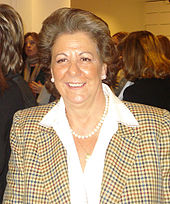 Mayor Rita Barberá in 2008.
Mayor Rita Barberá in 2008.
- Ciutat de les Arts i les Ciències (City of Arts and Sciences). Designed by the Valencian architect Santiago Calatrava, it is situated in the former Túria river-bed and comprises the following monuments:
- Palau de les Arts Reina Sofía, a flamboyant opera and music palace with four halls and a total area of 37,000 m2 (398,000 sq ft).
- L'Oceanogràfic, the largest aquarium in Europe, with a variety of ocean beings from different environments: from the Mediterranean, fishes from the ocean and reef inhabitants, sharks, mackerel swarms, dolphinarium, inhabitants of the polar regions (belugas, walruses, penguins), coast inhabitants (sea lions), etc. L'Oceanogràfic exhibits also smaller animals as coral, jellyfish, sea anemones, etc.
- El Museu de les Ciències Príncipe Felipe, an interactive museum of science but resembling the skeleton of a whale. It occupies around 40,000 m² on three flats.
- Museu de Prehistòria de València (Prehistory Museum of Valencia)
- Museu Valencià d'Etnologia (Valencian Museum of Ethnology)
- House Museum Blasco Ibáñez
- IVAM – Institut Valencià d'Art Modern – Centre Julio González Julio González Centre – Valencian Institute of Modern Art
- Museu de Belles Arts San Pío V (Museum of Fine Arts)
- Museu Faller (Falles Museum)
- Museu d'Història de València (Museum of History of Valencia)
- Museu Taurí de València (Bullfighting Museum
- MuVIM – Museu Valencià de la Il·lustració i la Modernitat (Valencian Museum of Enlightenment and Modernity)
- Museo Nacional de Cerámica y de las Artes Suntuarias / Museu Nacional de Ceràmica i Arts Sumptuàries González Martí (National Museum of Pottery and Sumptuary Arts González Martí)
People born in Valencia and Valencia province
- Pope Alexander VI, Pope from 1492 to 1503.
- Ibn al-Abbar (1199–1260), poet and diplomat
- Ausiàs March, poet.
- Joan Roís de Corella, poet and writer.
- Pope Callixtus III, Pope from 1455 to 1458.
- Luis de Santángel, finance minister.
- Alfonso III, King of Aragon and Count of Barcelona (as Alfons II).
- King James II of Aragon.
- King Peter III of Aragon (Peter the Great).
- Josu De Solaun Soto, classical music pianist.
- Guillén de Castro, famous Spanish writer of the Spanish Golden Age (1569–1631).
- Joanot Martorell (1413–1468), knight and writer the author of the novel Tirant lo Blanch.
- Vicente Blasco Ibáñez, Spanish realist novelist writing in Spanish, a screenwriter and occasional film director (1867–1928).
- Joaquin Sorolla, painter, who excelled in the painting of portraits, landscapes, and monumental works of social and historical themes.
- Joan Lluís Vives, a scholar and humanist.
- José Benlliure y Gil, painter.
- Antonio José Cavanilles, taxonomic botanist.
- José Iturbi, conductor and pianist.
- Luis García Berlanga, film director and screenwriter.
- Saint Vincent Ferrer, Dominican missionary and logician.
- Nino Bravo (birth name, Luis Manuel Ferri Llopis), popular singer (1944–1973)
- Santiago Calatrava, internationally recognized and award-winning architect.
- Joan Fuster, philologist, historian and writer.
- Josep Maria Bayarri, linguist, poet and writer.
- Joaquin Rodrigo, music composer.
- Manuel Palau, music composer.
- Raimon, composer and singer.
- Francisco Tárrega, influential Spanish composer and guitarist.
- Enric Valor i Vives, grammarian and writer.
- Manuel Sanchis i Guarner, philologist, historian and writer.
- María Teresa Fernández de la Vega, Spanish Socialist Workers' Party politician and the first female First Deputy Prime Minister of Spain.
- Salvador Larroca, comic book artist.
- Raul Albiol, footballer
- Vicente Gandia, painter, artist (1935–2009)
- Victor Claver, basketball star
Economy
Valencia has enjoyed strong economic growth over the last decade, much of it spurred by tourism and the construction industry.[citation needed] Air Nostrum, a regional airline, is headquartered in Valencia.[12]
Port
Valencia’s port is the biggest on the Mediterranean Western coast,[13] the first of Spain in Container Traffic as 2008[14] and the second of Spain[15] in total traffic, handling 20% of Spain’s exports.[16] The main exports are food and drinks. Other exports include oranges, furniture, ceramic tiles, fans, textiles and iron products. Valencia’s manufacturing sector focuses on metallurgy, chemicals, textiles, shipbuilding and brewing. Unemployment is lower than the Spanish average. Small and medium sized industries are an important part of the local economy.
Following the announcement that the 32nd America's Cup would be held in Valencia in 2007, the port underwent radical changes in which the port was divided into two parts, one part remaining unchanged while the other section would be used exclusively for the America's Cup festivities. The two sections are now divided by a wall that goes deep into the water in an attempt to maintain clean water for the America's Cup side.
Tourism
Formerly an industrial city, Valencia saw rapid development that started in the mid-1990s, expanding its cultural and touristic possibilities, which turned it into a vibrant city, restoring old landmarks like the old Towers of the medieval city (Serrano Towers and Quart Towers), monasteries like the San Miguel de los Reyes monastery, which now holds a specialized library, the whole Malvarrosa beach, with the construction of a 4 km (2 mi) long paseo or complete quarters, like the old Carmen Quarter, which has seen extensive renovation.
Another appealing feature of the city is its numerous convention centres, like the Valencia Fair (Feria de Valencia), the Conference Palace (Palau de Congressos) and several 5 star hotels.
Valencia's America's Cup competitions took place in June and July 2005 and were key attractions during the summer of 2005. According to official data from the organizing committee, as many as 150,000 visitors flocked to Valencia's port each day during the two-week events.[citation needed]
Demographics
One notable demographic change in Valencia in the last decade has been the growth in the foreign born population which has risen from 1.5% in the year 2000[17] to 15.1% in 2009,[18] a trend that has also occurred in the two larger cities of Madrid and Barcelona[19] The main countries of origin were Ecuador, Bolivia, Colombia, Morocco and Romania.[20] Between 2007 and 2008 there was a 14% increase in the foreign born population with the largest numeric increases by country being from Bolivia, Romania and Italy.
Climate
Valencia experiences a hot-summer Mediterranean climate (Köppen climate classification Csa),[21] with Semi-arid climate (BSh) influences.
Its average annual temperature is 17.8 °C (64.0 °F): 22.3 °C (72.1 °F) during the day and 13.3 °C (55.9 °F) at night. In the coldest month - January - the temperature typically ranges from 10 to 18 °C (50 to 64 °F) during the day, and 2 to 12 °C (36 to 54 °F) at night, with the average sea temperature being between 13–14 °C (55–57 °F). In the warmest month - August - the temperature during the day typically ranges from 28–34 °C (82–93 °F), above 23 °C (73 °F) at night, the average sea temperature is 26 °C (79 °F). Sunshine hours are up to 2,660 per year, from 150 (average 4.8 hours of sunshine / day) in December to 314 (average 10 hours of sunshine / day) in July. Average relative humidity is 60% in April to 68% in August.[22] Average number of days above 21 °C (70 °F) is 200, average number of days above 32 °C (90 °F) is 11 (1 in June, 4 in July, 4 in August and 2 in September).[23] Generally, summer temperatures similar to those experienced in northern Europe last about 8 months (from April to November). Two months (December and March) are transitional, with temperatures above 20 °C (68 °F) sometimes occurring.
Climate data for Valencia Month Jan Feb Mar Apr May Jun Jul Aug Sep Oct Nov Dec Year Average high °C (°F) 16.1
(61.0)17.2
(63.0)18.7
(65.7)20.2
(68.4)22.8
(73.0)26.2
(79.2)29.1
(84.4)29.6
(85.3)27.6
(81.7)23.6
(74.5)19.5
(67.1)16.8
(62.2)22.3 Daily mean °C (°F) 11.5
(52.7)12.6
(54.7)13.9
(57.0)15.5
(59.9)18.4
(65.1)22.1
(71.8)24.9
(76.8)25.5
(77.9)23.1
(73.6)19.1
(66.4)14.9
(58.8)12.4
(54.3)17.8 Average low °C (°F) 7.0
(44.6)7.9
(46.2)9.0
(48.2)10.8
(51.4)14.1
(57.4)17.9
(64.2)20.8
(69.4)21.4
(70.5)18.6
(65.5)14.5
(58.1)10.4
(50.7)8.1
(46.6)13.4 Precipitation mm (inches) 36
(1.42)32
(1.26)35
(1.38)37
(1.46)34
(1.34)23
(0.91)9
(0.35)19
(0.75)51
(2.01)74
(2.91)51
(2.01)52
(2.05)454
(17.87)Avg. precipitation days (≥ 1 mm) 4 3 4 5 5 3 1 2 4 5 4 5 44 Sunshine hours 169 169 212 229 256 271 314 285 237 201 167 150 2,660 Source: World Meteorological Organization (UN),[24] Agencia Estatal de Meteorología[22] Culture
Valencia is known for Las Fallas, which is a famous local festival held in March, for paella valenciana, traditional Valencian ceramics, intricate traditional dress, and the striking new architecture of the City of Arts and Sciences designed by its own son, architect Santiago Calatrava.
La Tomatina, an annual tomato fight, draws crowds to the nearby town of Buñol in August. There are also a number of well preserved Catholic fiestas throughout the year. Holy week celebrations in Valencia are considered the most colourful in Spain. Valencia has a metro system, the Valencia Metro.
Valencia is the current location of the Formula One European Grand Prix, first hosting the event on 24 August 2008. The city will host the event until at least 2014.
The University of Valencia (official name Universitat de València) is one of the oldest surviving universities, the oldest university in the Kingdom of Valencia, and is regarded as one of the Spanish leading academic institutions.[citation needed]
Languages
The two official languages spoken in the city are Valencian and Castilian. Due to political and demographic pressure in the past, the predominant language is Castilian, but Valencian is taught and spoken in most of the surrounding metropolitan area and province of Valencia.[25] The government emphasizes the usage of the local language by posting signs and announcements of the metro area in Valencian with Castilian translations. It is also notable to mention that Valencian is also used when naming streets. Street signs generally give the Valencian name for the street. However, streets that are older and generally span longer distances are also labeled with Castilian. This results in a situation where streets have two names, although this is generally not too confusing because there is a similarity between Castilian and Valencian spellings and vocabulary.
Food
Valencia is famous for its wonderful gastronomic culture. Paella – a simmered rice dish that includes seafood or meat (chicken and rabbit). Fartons, buñuelos, Spanish omelette, rosquilletas and squid (calamares) are some examples of typical Valencian foods.
Sport
Football
Valencia is also famous for its football club Valencia C.F., which won the Spanish league recently in 2002 and 2004 (in which year it also won the UEFA Cup) and 6 times total, and was also a UEFA Champions League runner-up in 2000 and 2001, it is one of the most famous football clubs in Spain and Internationally. Their stadium is the Mestalla. Its city rival Levante UD also plays in the highest division after gaining promotion two years ago, their stadium is Estadi Ciutat de València. And now from the year 2011 there will be a third team in the city, Huracán Valencia, who play their games in Municipal de Manises and play in the Segunda División B.
Motor Sports
Once a year the European Formula One Grand Prix takes place in Valencia Street Circuit. Furthermore, the motorcycle Grand Prix running, the show jumping tournament of the worldwide champions’ tour, an ATP 500 tennis tournament, or the DTM can be visited in Valencia.
Transportation
Public transport is provided by the Ferrocarrils de la Generalitat Valenciana (FGV) which operates the Metrovalencia and other rail and bus services. Valencia Airport is situated 9 km (5.6 mi) west of downtown Valencia. The Estación del Norte or North Station is the main railway terminus in Valencia. A new temporary station, Estación de València-Joaquín Sorolla, has been built on land adjacent to this terminus to accommodate high speed AVE trains to and from Madrid, Barcelona, Seville and Alicante.
Districts
- Ciutat Vella: La Seu, La Xerea, El Carmen, El Pilar, El Mercado, San Francisco.
- Extensió: Russafa, El Pla del Remei, Gran Via.
- Extramurs: El Botànic, La Roqueta, La Pechina, Arrancapins.
- Campanar: Campanar, Les Tendetes, El Calvari, Sant Pau.
- La Saïdia: Marxalenes, Morvedre, Trinitat, Tormos, Sant Antoni.
- Pla del Real: Exposició, Mestalla, Jaume Roig, Ciutat Universitària
- Olivereta: Nou Moles, Soternes, Tres Forques, La Fontsanta, La Luz.
- Patraix: Patraix, Sant Isidre, Vara de Quart, Safranar, Favara.
- Jesús: La Raiosa, L'Hort de Senabre, The Covered Cross, Saint Marcelino, Real Way.
- Quatre Carreres: Montolivet, En Corts, Malilla, La Font de Sant Lluís, Na Rovella, La Punta, Ciutat de les Arts i les Ciències.
- Poblats Marítims: El Grau, El Cabanyal, El Canyameral, La Malva-Rosa, Beteró, Nazaret.
- Camins del Grau: Aiora, Albors, Creu del Grau, Camí Fondo, Penya-Roja.
- Algiròs: Illa Perduda, Ciutat Jardí, Amistat, Vega Baixa, la Carrasca.
- Benimaclet: Benimaclet, Camí de Vera.
- Rascanya: Orriols, Torrefiel, Sant Llorenç.
- Benicalap: Benicalap, Ciutat Fallera.
- Pobles del Nord: Benifaraig, Poble Nou, Carpesa, Cases de Bàrcena, Mauella, Massarrojos, Borbotó.
- Pobles de l'Oest: Benimàmet, Beniferri.
- Pobles del Sud: Forn d'Alcedo, Castellar-l'Oliveral, Pinedo, el Saler, el Palmar, el Perellonet, la Torre,
Gallery
-
View of the cathedral
-
A falla
-
The paella originated in Valencia, Spain and later spread to other Spanish cities
Twin towns - Sister cities
 Mainz, Germany, since 4 August 1978[26]
Mainz, Germany, since 4 August 1978[26] Bologna in Italy, since 29 June 1979[26]
Bologna in Italy, since 29 June 1979[26] Veracruz, Mexico, since 26 September 1984[26]
Veracruz, Mexico, since 26 September 1984[26] Sacramento, United States, since 29 June 1989[26]
Sacramento, United States, since 29 June 1989[26] Valencia, Venezuela, since 20 March 1982[26]
Valencia, Venezuela, since 20 March 1982[26] Odessa, Ukraine, since 13 May 1982[26]
Odessa, Ukraine, since 13 May 1982[26] Burgos, Spain
Burgos, Spain
See also
- Valencia City Council elections
- Archdiocese of Valencia
- Benimaclet
- El Cid
- Ibn al-Abbar
- Spanish wine
- Valencia Metro (Spain)
- Valencia Street Circuit
- Llotja de la Seda
References
 This article incorporates text from a publication now in the public domain: Herbermann, Charles, ed (1913). "Archdiocese of Valencia". Catholic Encyclopedia. Robert Appleton Company.
This article incorporates text from a publication now in the public domain: Herbermann, Charles, ed (1913). "Archdiocese of Valencia". Catholic Encyclopedia. Robert Appleton Company. This article incorporates text from a publication now in the public domain: Smith, William, ed (1854–57). "article name needed". Dictionary of Greek and Roman Geography. London: John Murray.
This article incorporates text from a publication now in the public domain: Smith, William, ed (1854–57). "article name needed". Dictionary of Greek and Roman Geography. London: John Murray.
Notes
- ^ "Instituto Nacional de Estadística. (National Statistics Institute)". Ine.es. 28 May 2001. http://www.ine.es. Retrieved 6 May 2009.
- ^ "Demographia: World Urban Areas" (PDF). http://www.demographia.com/db-worldua.pdf. Retrieved 2011-03-09.
- ^ Eurostat - Larger Urban Zones: Urban Audit.org
- ^ Valencia (1,583,331) and Sagunto (122,411)
- ^ Datos de áreas urbanas en 2006 según el proyecto AUDES5
- ^ Conurbaciones en 2006 según el proyecto AUDES5
- ^ Organization for Economic Cooperation and Development, Competitive Cities in the Global Economy, OECD Territorial Reviews, (OECD Publishing, 2006), Table 1.1
- ^ "About the Santo Caliz (Holy Chalice)". Catholicnews.com. http://www.catholicnews.com/data/stories/cns/0603899.htm. Retrieved 2011-03-09.
- ^ Announcement of the election as host city for 33rd America's Cup[dead link]
- ^ "La Lonja listing on Unesco site". Whc.unesco.org. http://whc.unesco.org/en/list/782. Retrieved 2011-03-09.
- ^ "Valencia’s unique 'Water Court'". Reality Sense. http://www.realitysense.com/valencia-water-court-tribunal-de-las-aguas/. Retrieved 2011-01-31.
- ^ "Contact List." Air Nostrum. Retrieved on 20 May 2009.
- ^ "Valenciaport in figures". valenciaport.com. http://www.valenciaport.com/en-US/ValenciaportEntorno/ValenciaportCifras/Introduccion/Paginas/ValenciaportCifras.aspx. Retrieved 2009-01-01.
- ^ Burguera. "Valencia supera a Algeciras y lidera por primera vez el tráfico de contenedores en España. Las Provincias" (in Spanish). Lasprovincias.es. http://www.lasprovincias.es/valencia/20080910/economia/valencia-supera-algeciras-lidera-20080910.html. Retrieved 18 June 2009.
- ^ "Resumen general del tráfico portuario en febrero | Puerto Bahía de Algeciras Blog". Puertoalgeciras.org. 22 February 1999. http://www.puertoalgeciras.org/2008/04/resumen-general-del-trafico-portuario.html. Retrieved 18 June 2009.
- ^ Mckinley, James C. (2011-03-02). "NY Times, 30 July 2008". Nytimes.com. http://www.nytimes.com/global/spainvalencia/nine.html. Retrieved 2011-03-09.[dead link]
- ^ "foreign born population in 2001". http://www.ayto-valencia.es/ayuntamiento/webs/estadistica/Padron/2001/Pob_estrangera_2001.xls. Retrieved 2011-03-09.
- ^ "Foreign born population in 2008, p7" (PDF). http://www.ayto-valencia.es/ayuntamiento/otras_publicaciones.nsf/0/44A5D00DFB826F6DC12575E00027F9CA/$FILE/Pob_Estrangera_2009.pdf. Retrieved 2011-03-09.
- ^ "Table 1.1 foreign born population". http://www.ayto-valencia.es/ayuntamiento/webs/estadistica/Padron/2007/Pob_estrangera_2007.xls. Retrieved 2011-03-09.
- ^ "Table 1.5 foreign born population 2007". http://www.ayto-valencia.es/ayuntamiento/webs/estadistica/Padron/2007/Pob_estrangera_2007.xls. Retrieved 2011-03-09.
- ^ M. Kottek; J. Grieser, C. Beck, B. Rudolf, and F. Rubel (2006). "World Map of the Köppen-Geiger climate classification updated". Meteorol. Z. 15: 259–263. doi:10.1127/0941-2948/2006/0130. http://koeppen-geiger.vu-wien.ac.at/pics/kottek_et_al_2006.gif. Retrieved 22 April 2009.
- ^ a b "Valores Climatológicos Normales. Valencia". http://www.aemet.es/es/elclima/datosclimatologicos/valoresclimatologicos?l=8416&k=val.
- ^ "Historical Weather for Valencia, Spain". Weatherbase. http://www.weatherbase.com/weather/weatherall.php3?s=48280&refer=&units=metric. Retrieved 2011-03-09.
- ^ "Weather Information for Valencia". http://www.worldweather.org/083/c01238.htm.
- ^ "Institut Valencià d'Estadística". Ive.es. http://www.ive.es/portal/page/portal/IVE_PEGV/CONTENTS/censos/censo2001definitivos/ini_val.htm. Retrieved 2011-03-09.
- ^ a b c d e f g "Municipality of Valencia: ciudades hermanadas con Valencia". http://www.valencia.es/ayuntamiento/rinternacionales_accesible.nsf/vDocumentosTituloAux/D80022569C2533B9C12571F100285E72?OpenDocument&bdOrigen=ayuntamiento%2Frinternacionales_accesible.nsf&idapoyo=&lang=1&nivel=3. Retrieved 2 November 2008.
External links
- Valencia, Spain travel guide from Wikitravel
- Official website of the city of Valencia (Spanish) (English) (Valencian) (French)
- Official tourism website of the city of Valencia (Spanish) (English) (German) (French) (Italian) (Japanese) (Chinese) and in Valencian + easy-access static pages in all eight languages
- Valencia on Wikitravel
- Official website of the Community Valenciana tourism
- Valencia-La Ciudad de las Artes y de las Ciencias
- Website of the Zoo in Valencia
Categories:- Valencia, Spain
- Ancient mints
- Comarques of the Valencian Community
- Former national capitals
- Mediterranean port cities and towns in Spain
- Municipalities in Valencia
- Populated coastal places in Spain
- Populated places established in the 2nd century BC
- Roman sites in Spain
- 137 BC establishments
- Populated places in Valencia
- Ciutat de les Arts i les Ciències (City of Arts and Sciences). Designed by the Valencian architect Santiago Calatrava, it is situated in the former Túria river-bed and comprises the following monuments:
Wikimedia Foundation. 2010.

